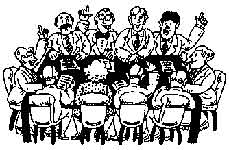The Problem
Developing a Plan
Research & Data Collection
PART 4
Analysis of Data
Recommendation and Final Presentation Report
Part 1 - The Problem
Let's take time and review the problem
at hand, so we can develop a better idea for planning to solve the problem!
Letter from the Lemont Library

1. Library has noticed a decline in student attendance, and wondering why?
2. Library's funding is in danger of being cut for lack of student interest.
3. Library asked for your help in making the library a place that students would like to use.
4. They also need your help in determining the kinds of books kids really like to read.
Part 2 - Developing a Plan
After completing the brainstorming
activities and addressing the issues and analyzing the problem at hand,
it is now time to develop a plan of attack.
Groups will be formed (whole class participation) based upon the brainstorming
completed in Problem Analysis section of this project.
Once you have chosen an area of investigation please consider the following
questions while working on your plan:
1. What is the Library's problem?
2. What information and data can be gathered to solve this problem?
3. How can your team of experts, along with other students help solve
this problem?
While working as a team, make sure
you follow these guidelines:
1. Assign roles for working together in
your group.
2. Keep a daily personal journal, and answer the questions
posted each day.
3. Consider all possible resources to help
you along the way.
Part 3 - Research and Data Collection
How are you going to go about collecting
and analyzing your data/information?
How are you going to organize your information/data?
One way of collecting data would be an online database. Follow the directions on how to develop an online database to keep track of your data. The database can be developed through FileMaker Pro, posted to a web site, and allow users to enter information to your database automatically.
You will then need to sort and evaluate
the contents of the database in order to use this information to report
back your findings.
Part 4 - Analysis of Data
How is your team going to draw conclusions
from your data?
Consider the following essential questions:
What data did you collect?
What other data did you use?
What other resources did you use (beside the database collection)?
What did you find out?
Do you feel you have enough data to make a recommendation?
What other questions do you have at this point?
![]()
Part 5 - Recommendation and Final Presentation Report
Your group will be presenting your recommendations for possible ways to make the library more appealing to students, parents, and the general public in a multimedia project.
PowerPoint Presentation
HyperStudio Prsentation
Internet Web Page

Check out these rubric for each stage of your project.
Created for the Fermilab LInC program sponsored by Fermi National Accelerator Laboratory Education Office and Friends of Fermilab, and funded by United States Department of Energy, Illinois State Board of Education, North Central Regional Technology in Education Consortium which is operated by North Central Regional Educational Laboratory (NCREL), and the National Science Foundation.
Author(s): Ronda
Larson-Dranter, Mary
A. Warren
School: Old Quarry Middle School, Lemont, Illinois
Created: February 15, 2001 - Updated: April
3, 2001
URL: /lincon/w01/projects/library/student1.html